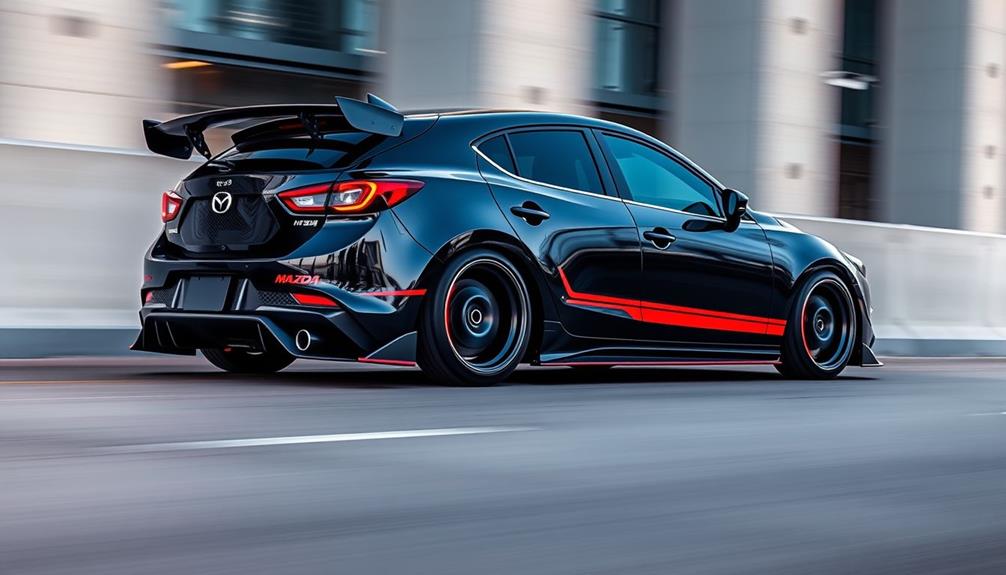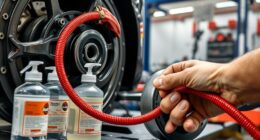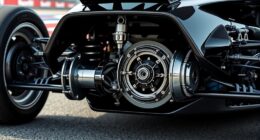Tuning your Mazda CX-9 can really boost its power and efficiency. Upgrading components like the intake, exhaust system, and ECU can elevate horsepower from 220 hp to about 251 hp or more. Installing a turbocharger might even push it to 330 hp, enhancing engine efficiency and throttle response. Plus, adopting better driving habits and using ethanol-free fuel can lead to significant fuel economy improvements. Regular maintenance like timely oil changes keeps everything running smoothly. Interested in discovering effective ways to enhance your driving experience further?
Key Takeaways
- Upgrading to a turbocharger can increase the Mazda CX-9's horsepower by over 50%, enhancing overall performance significantly.
- ECU tuning optimizes fuel delivery and ignition timing, potentially raising horsepower from 220 hp to approximately 251 hp.
- Installing a high-flow exhaust system improves airflow, contributing to better power delivery and an enhanced sound profile.
- Regular maintenance, including timely oil changes and air filter replacements, is essential for maximizing engine efficiency and performance.
- Using ethanol-free fuel can improve fuel economy and engine performance, especially under load, compared to ethanol blends.
Understanding the Mazda CX-9
The Mazda CX-9 stands out with its robust V6 3.7L engine, delivering a solid 220 hp and impressive torque between 310-314 Nm. This SUV's design features an air-fuel ratio of 14.7:1 up to 5000 RPM, which is aligned with standard performance metrics for V6 power plants.
While the stock performance is commendable, you'll find the Mazda CX offers significant tuning potential. By implementing modifications like upgraded intakes and exhaust systems, you can boost the peak horsepower to 251 hp.
Tuning not only enhances power but also addresses power dips at lower RPMs. This means you can enjoy a smoother driving experience and more responsive acceleration. Regular maintenance and tuning adjustments are essential, especially when you opt for aftermarket modifications, ensuring your CX-9 operates efficiently and effectively.
If you're looking to maximize your vehicle's capabilities, understanding the tuning aspects of the Mazda CX-9 is vital. Whether you're interested in squeezing out extra horsepower or improving efficiency, tuning can transform your driving experience, making it more enjoyable and powerful.
Embrace the potential of your CX-9 and explore the world of tuning!
Performance Enhancements Overview

When it comes to enhancing your Mazda CX-9's performance, several modifications can make a significant difference.
Installing a turbocharger, fine-tuning the ECU, and upgrading the exhaust system are key areas to contemplate for boosting power and efficiency.
Let's explore how each of these enhancements can transform your driving experience.
Turbocharger Installation Benefits
Turbocharging your Mazda CX-9 opens the door to a world of performance enhancements, transforming your driving experience. If it's your first time considering a turbocharger, let's see how it can elevate your SUV's capabilities.
By installing a turbocharger, you can expect a considerable increase in horsepower—often 50% or more—bringing your total output closer to 330 hp with proper tuning. The turbocharger enhances engine efficiency by forcing more air into the combustion chamber, which leads to better fuel atomization and improved power delivery. You'll notice reduced turbo lag when paired with upgraded components like a high-flow exhaust system and a larger intercooler, resulting in faster throttle response and acceleration.
Here's a quick overview of the benefits:
| Benefit | Description | Impact |
|---|---|---|
| Increased Horsepower | Boosts total output considerably | +50% power |
| Enhanced Engine Efficiency | Better fuel atomization for peak performance | Improved MPG |
| Reduced Turbo Lag | Upgraded components decrease lag time | Quicker response |
| Better Throttle Response | Faster acceleration with improved tuning | More control |
| Peak Fuel Economy | Potential for better fuel economy during highway driving | Cost savings |
With these benefits, turbocharging is a game changer for your CX-9!
ECU Tuning Techniques
ECU tuning techniques offer a powerful way to release your Mazda CX-9's full potential. By modifying the engine control unit's parameters, you can optimize fuel delivery, ignition timing, and boost pressure, leading to considerable performance enhancements.
With a well-executed ECU tune, you can expect power gains of 10-30%, depending on your vehicle and any additional modifications you've made.
For instance, the 3.7L V6 engine in your CX-9 can achieve peak horsepower increases from 220 hp to around 251 hp when properly tuned. This showcases the effectiveness of tuning techniques.
One critical adjustment involves optimizing the air-fuel ratio, shifting from a stock ratio of 14.7:1 to a more aggressive 12.6:1. This alteration can greatly improve engine performance and responsiveness.
However, to guarantee your tuning is effective and sustainable, collaborating with tuning experts is often necessary. They can help address any ECU protocol issues and accurately calibrate your vehicle's performance enhancements.
With the right ECU tuning techniques, you'll unleash the true power and efficiency of your Mazda CX-9, turning your full-size SUV into a more thrilling driving experience.
Exhaust System Modifications
Upgrading your Mazda CX-9's exhaust system can greatly enhance its performance by improving airflow and power delivery. By installing modifications like V6 headers and Borla mufflers, you could see a significant boost in horsepower—up to 251 hp from the stock 220 hp.
A full exhaust system designed for peak flow not only increases power but also enhances the sound profile, giving you a sportier driving experience.
The installation of performance exhaust parts is often straightforward, making DIY modifications accessible. These enhancements promote better engine efficiency, but it's vital to maintain an appropriate air-fuel ratio during tuning. Adjusting from 14.7:1 to 12.6:1 post-modifications guarantees you maximize the benefits of your upgrades.
Regular dyno tests after modifications are essential for fine-tuning your vehicle's performance. These tests help correct power dips at lower RPMs and confirm that your Mazda CX-9 runs at its best.
With the right exhaust system modifications, you'll enjoy not just improved performance but also a more engaging driving experience. So, why wait? Start planning your exhaust upgrades today!
Key Modifications for Power
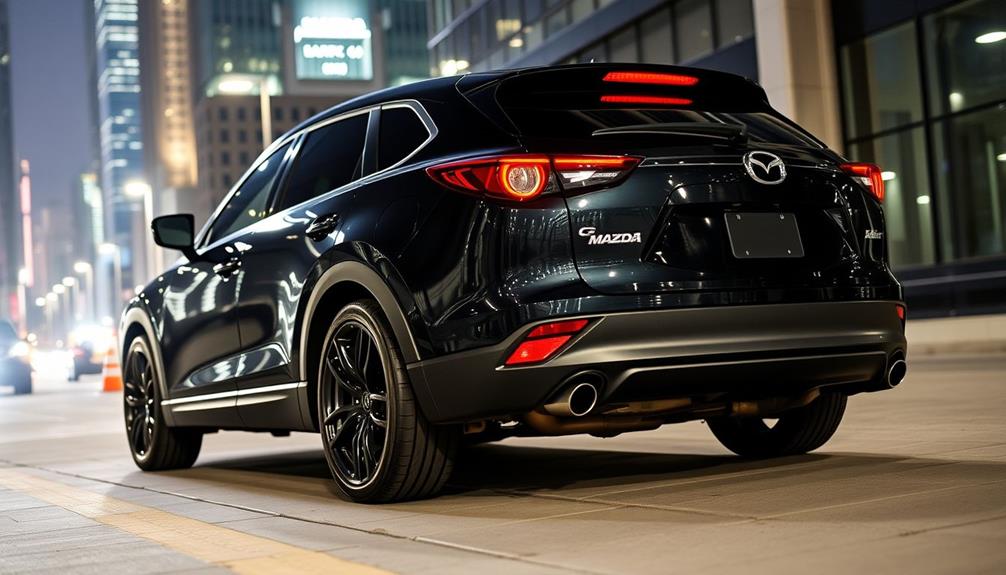
Maximize your Mazda CX-9's performance with a few key modifications that focus on power enhancement.
Start by upgrading to a K&N open type intake. This change enhances airflow, directly contributing to increased horsepower.
Next, consider installing a full exhaust system that includes V6 headers and Borla mufflers. This setup improves exhaust flow, resulting in a noticeable power boost.
Another vital modification involves replacing the throttle body and mass airflow sensor. These components help optimize air intake, further enhancing your engine's performance.
After making these changes, it's important to conduct post-modification dyno testing. You might see a peak horsepower increase from 220 hp to 251 hp, showcasing the effectiveness of your enhancements.
Fuel Efficiency Improvements

When it comes to improving your Mazda CX-9's fuel efficiency, small changes in your driving habits can make a big difference.
Using ethanol-free fuel and keeping up with regular maintenance not only boosts performance but also enhances your MPG.
Let's explore how you can maximize your fuel economy while enjoying the ride.
Driving Habits Impact Efficiency
Adopting better driving habits can greatly boost your Mazda CX-9's fuel efficiency. Simple changes in your driving style can lead to impressive improvements, with potential gains of 10-30% from smoother acceleration and deceleration. Using cruise control on highways helps maintain a consistent speed, which can improve fuel economy by 7-14%.
Here's a quick reference to help you enhance your driving habits:
| Driving Habit | Potential Fuel Efficiency Improvement | Notes |
|---|---|---|
| Gradual Acceleration/Deceleration | 10-30% | Reduces engine load and fuel consumption. |
| Using Cruise Control | 7-14% | Maintains steady speed, reduces braking. |
| Keeping Tire Pressure Ideal | Up to 3% per PSI drop | Check pressure regularly for efficiency. |
| Regular Vehicle Maintenance | 4-6% | Oil changes and air filter replacements boost performance. |
| Driving at Moderate Speeds | Best efficiency at 45-60 mph | Reduces aerodynamic drag considerably. |
Ethanol-Free Fuel Benefits
Switching to ethanol-free 91 octane fuel can greatly enhance your Mazda CX-9's performance and fuel efficiency. Compared to ethanol-blend fuels, this high-octane option can improve your fuel economy by up to an additional 0.5 MPG. This may seem small, but over time, it can add up to significant savings at the pump.
The higher octane content of ethanol-free fuel allows your engine to perform better, especially when under load. You'll notice improved acceleration and responsiveness, which can make your driving experience more enjoyable.
While modern vehicles like your CX-9 are designed to handle ethanol blends, using ethanol-free gasoline can yield better mileage and overall engine performance in some cases.
Keep in mind that the availability and pricing of ethanol-free fuel can vary depending on state regulations. It's often more expensive than standard E10 blends, but the benefits to your vehicle's power and efficiency may justify the extra cost.
If you're looking to get the most out of your Mazda CX-9, consider making the switch to ethanol-free fuel for a noticeable boost in both performance and economy.
Regular Maintenance Essentials
Your Mazda CX-9's performance and fuel efficiency can greatly benefit from regular maintenance routines. Start with timely oil changes using the recommended oil weights, like 0W20 or 5W30. This keeps your engine running smoothly and efficiently.
Don't forget to change air filters and spark plugs at the recommended intervals. These components guarantee a proper air-fuel mixture, enhancing combustion efficiency and improving your MPG.
Next, keep an eye on your tire pressure. Maintaining it at the manufacturer's recommended levels can considerably enhance fuel efficiency. Under-inflated tires increase rolling resistance, causing you to burn more fuel.
Also, periodically check your exhaust system. A clean and efficient exhaust reduces back pressure, which can lead to better engine performance and efficiency.
Lastly, use cruise control on highways. It helps maintain a steady speed, reducing engine strain and improving fuel economy.
Maintenance for Optimal Performance
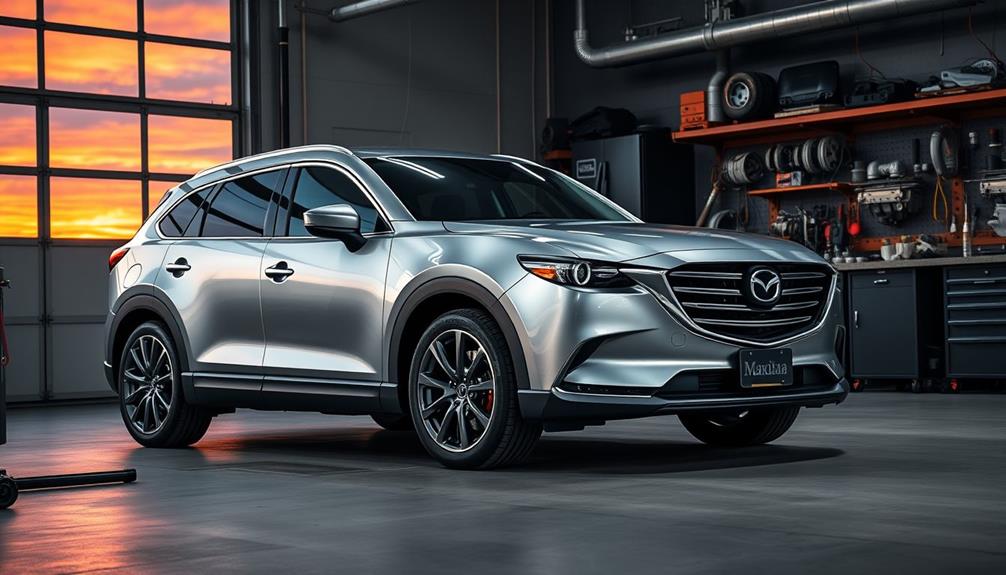
Maintaining your Mazda CX-9's performance requires diligent attention to several key aspects. First, don't overlook regular maintenance tasks, such as changing spark plugs and air filters. These components are essential for peak engine performance, guaranteeing your SUV runs smoothly and efficiently.
Before diving into any performance upgrades, check for error codes by reading the OBD2 memory; this helps you avoid addressing any underlying issues that may hinder your efforts.
Fluid checks are also vital—regularly inspect your oil and coolant levels to prevent major engine problems and extend the life of your vehicle. Using the recommended oil weights, like 0W20 or 5W30, can greatly impact your engine's efficiency, leading to better performance and fuel economy.
Additionally, periodic inspections of the exhaust system can enhance overall vehicle efficiency, allowing you to maintain the effectiveness of any modifications you make.
Real-World User Experiences
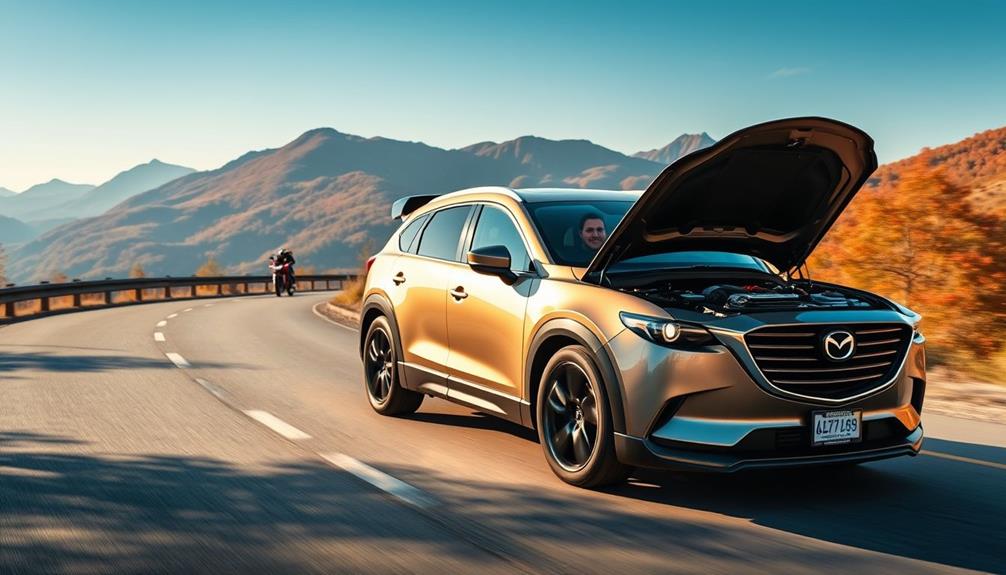
Experiencing the transformation of a Mazda CX-9 through tuning modifications has become a popular journey for many owners.
You'll find that after implementing upgrades like a K&N intake and a full exhaust system, you can boost your horsepower from 220 to 251—a remarkable increase of 31 horsepower. Users also report improved air-fuel ratios, shifting from 14.7:1 to 12.6:1, which enhances both fuel efficiency and overall performance.
However, maneuvering this tuning process can be complex. Many owners emphasize the need for professional ECU tuning to address initial challenges during remapping.
Continuous dyno testing is highly recommended to fine-tune performance and correct any power dips at lower RPMs.
Here are some key takeaways from real-world experiences:
- Collaborate with tuning experts for effective modifications.
- Prioritize professional ECU remapping to avoid issues.
- Regular dyno testing helps optimize vehicle performance.
- Monitor air-fuel ratios for efficient fuel usage.
- Be prepared for an ongoing tuning journey to achieve peak performance.
Navigating Performance Claims

How can you discern genuine performance claims from mere marketing hype? When considering performance chips like the SLR Motorsports chip, which claims to boost horsepower by over 50 and improve fuel efficiency by 3-6 MPG, skepticism is key. Many users find these claims exaggerated.
To navigate this landscape, it helps to analyze the claims critically. Here's a quick reference table:
| Claim Type | Typical Claims | Skeptical Considerations |
|---|---|---|
| Performance Chips | +50 HP, +6 MPG | Often "too good to be true" |
| Price Point | Under $100 | Low cost often equals low results |
| Regulatory Oversight | Limited by FTC | Legal actions against misleading ads |
Always apply the "too good to be true" test. If a product promises drastic improvements at a low price, it's likely not delivering. Conduct thorough research and read user experiences before making a purchase. Many aftermarket products may not produce the performance or efficiency gains you expect, so stay informed and cautious.
Frequently Asked Questions
Can You Tune a Mazda Cx-9?
Yes, you can tune a Mazda CX-9. By upgrading components like the intake and exhaust, and adjusting the ECU, you'll enhance performance considerably. Just make certain you collaborate with experts for ideal results and regular dyno tests.
How to Boost Mazda Cx-9?
To release your Mazda CX-9's potential, consider upgrading the intake system, installing a full exhaust, and fine-tuning the ECU. Regular maintenance and quality aftermarket parts also keep your ride responsive and powerful.
Is the Mazda CX-9 Fuel Efficient?
The Mazda CX-9 isn't the most fuel-efficient option in its class. With an average of 18.4 MPG, you can improve efficiency by using high-octane fuel and maintaining your vehicle regularly for better performance.
What Does Sport Mode Do in a Mazda Cx-9?
When you activate Sport Mode in the Mazda CX-9, it adjusts shift points for quicker acceleration, enhances throttle response, tightens steering for better handling, and optimizes traction, creating a more engaging driving experience.
Conclusion
In tuning your Mazda CX-9, you're not just chasing numbers; you're transforming your driving experience. Imagine gliding smoothly on the highway, the engine purring with newfound power while still sipping fuel efficiently. You might worry that modifications could compromise reliability, but with the right upgrades, you can enhance both performance and durability. So, release your SUV's potential and enjoy the thrill of the road—where adventure and efficiency go hand in hand. Whether you’re looking for better acceleration, sharper handling, or just an overall boost in vehicle responsiveness, the right approach can make all the difference. With a few key **Mazda CX9 2008 tuning tips**, you’ll unlock performance gains that elevate your daily drives and weekend getaways alike. Take control of your SUV’s true capability and make every journey more engaging than the last.



